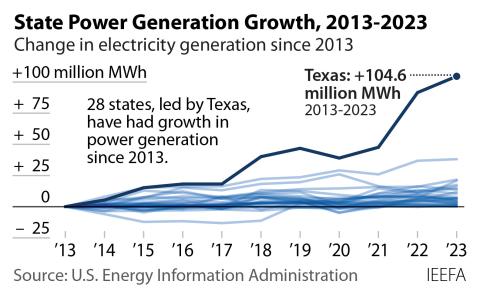IEEFA Update: Even Coal-Mining Companies Are Complaining About the Price They Pay for Coal-Fired Electricity
Public filings by U.S. coal-mining companies disclose vast data that is crucial to investors—which is the point of having such information publicly available.
They also yield revealing anecdotal notes that add perspective and depth to the numbers, and that include wrinkles of irony sometimes.
Some coal-fired power has gotten so expensive that coal producers are complaining about how much they have to pay for it.
In February, Peabody and Cloud Peak lost a fight with the Wyoming Public Service Commission over high electric rates tied to the cost of the Great Plains Synfuel Plant in Beulah, N.D. The plant is described in SEC filings as “the only commercial-scale coal gasification plant in the U.S. producing natural gas.” Its costs are passed on to customers via the Basin Electric Power Cooperative, which owns the plant, and its power distributor, Powder River Energy.
Peabody and Cloud Peak had wanted $13.2 million of the utility’s rate increases thrown out.
SNL has reported that “the plant has been losing millions of dollars” and that customers like Cloud Peak and Peabody have argued that they “should not be forced to help subsidize those losses through higher power rates” and that “the plant’s expenses are rolled into the electricity rates to support the money-losing gasification operation.” SNL reported also that “the latest power cost increase reflects that the plant’s losses have markedly increased due to natural gas market surpluses.”
To be clear, the gasification plant primarily produces natural gas from local lignite; most of the gas is sent to the East Coast via pipeline, but some of it is used at Basin Electric’s natural-gas-fired generating units. The plant runs on power from a 900-megawatt, lignite-fired plant, Antelope Valley Station, with which it is paired Overall, Basin Electric has 3,664 megawatts of coal-fired capacity; 1,188 megawatts of natural gas-fired capacity and 284 megawatts of wind capacity.
Coal-fired power has gotten so uneconomical that even coal-mining companies can’t make it work.
Colorado-based Westmoreland Coal, which runs mines in several states and Canada, built and recently owned two now-mothballed coal-fired electricity generating units in Weldon, N.C., at the 230-megawatt Roanoke Valley Energy Facility (ROVA). These units opened in 1994-95, so they weren’t even that old.
Westmoreland had longstanding power purchase agreements with Dominion North Carolina Power (DNCP) and Virginia Electric Power for all its generation from the plant. But this past December the company entered into a “substitute energy purchase agreement,” by which it is “no longer obligated to operate ROVA in order to fulfill its contracted energy and capacity requirements,” a change meant to mitigate “cash losses from generation through the sale to DNCP of substitute power not produced by ROVA.”
The North Carolina plant was losing too much money, in other words, which is why it was closed.
Realizing more than a year ago that the value of the plant was effectively “zero,” Westmoreland wrote them off to the tune of $133.1 million at the end of 2015, and got approval to deactivate the plants from PJM, the regional grid operator. That approval was effective March 1, 2017, and earlier this month Westmoreland sold the plant for $5 million.
While it’s been widely reported over the past few week that the U.S. coal industry is staging a recovery, coal companies keep losing money.
Foresight Energy lost $16.3 million in the second quarter of this year.
Westmoreland lost $21 million.
Cloud Peak lost $6.9 million.
Contura pulled its coal IPO last week because it could not generate enough investor interest in it.
There in fact isn’t much of a recovery going on, contrary to the narrative coming out of some of the coal industry itself, which perhaps is an irony in itself.
Seth Feaster is an IEEFA energy data analyst.
RELATED POSTS:
IEEFA Update: In Federal Coal-Policy Reversals, Trump Is Handing Out Snowballs in a Blizzard
IEEFA Update: The Coal ‘Comeback’ of 2017
IEEFA Update: Too Much Coal Is Being Mined Still for Too Few Customers











